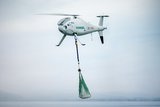DARPA tasks Northrop Grumman to demonstrate autonomous aerial refuelling
DARPA has announced the award of a $33 million contract to Northrop Grumman Corporation to demonstrate aerial refueling of a NASA Global Hawk unmanned aerial vehicle (UAV) by a sister ship.
The program will be designated KQ-X.
Northrop Grumman will retrofit two of the high altitude long endurance (HALE) UAVs, one aircraft pumping fuel into the other in flight through a hose-and-drogue refueling system. The aerial refueling engagement will be completely autonomous.
"Demonstrating the refueling of one UAV by another is a historic milestone," said Carl Johnson, vice president, Advanced Concepts for Northrop Grumman Aerospace Systems. "It adds aerial refueling to the list of capabilities that can be accomplished autonomously by Global Hawks; it opens the door to greatly expanded operational utility for UAVs; and, as a side benefit, it promises to increase the safety and reliability of aerial refueling between manned aircraft by reducing pilot workload."
There are several revolutionary aspects to the KQ-X program. Not only will the aerial refueling be autonomous, but since Global Hawks are HALE UAVs, it will also take place at a much higher altitude than has been previously demonstrated with manned aircraft. It will also be the first time that HALE UAVs have flown in formation.
"The importance of aerial refueling is clear in the way military aviation depends on it today," said Jim McCormick, the DARPA program manager for KQ-X. "This demonstration will go a long way towards making those same advantages a reality for the next generation of unmanned aircraft."
Engineering work will be accomplished at the Northrop Grumman Unmanned Systems Development Center in Rancho Bernardo, California.
Pilots from NASA, NOAA, and Northrop Grumman will fly the Global Hawks from the NASA Dryden Flight Research Center at Edwards Air Force Base, also in California. Sargent Fletcher, Inc. and Sierra Nevada Corporation are major KQ-X subcontractors.
By Northrop Grumman
More from Uncrewed Vehicles
-
Jammer resistant drone designs spark search for countermeasures
The Russia-Ukraine conflict has driven another stage of evolution for drones and the counter measures to defend against them.
-
![L3Harris launches Amorphous software for control of uncrewed platforms]()
L3Harris launches Amorphous software for control of uncrewed platforms
The new Amorphous software is a universal controller that would allow a single operator to control a swarm of “thousands” of uncrewed systems, from drones to underwater platforms.
-
ideaForge unveils new UAVs at Aero India 2025
India UAV supplier ideaForge has launched the Netra 5 and Switch V2 drones at Aero India 2025, boasting of enhanced endurance, AI-driven autonomy and improved operational capabilities.
-
![Shaping the future of defence: What 2025 holds for the global drone market]()
Shaping the future of defence: What 2025 holds for the global drone market
The UAV market is experiencing unprecedented growth, with innovations in technology and battlefield applications driving demand across military sectors. From the battlefields of Ukraine to NATO exercises and beyond, drones are transforming how wars are fought and supported.
-
![Maris-Tech confirms customers signing up for Jupiter Drones codec and AI-powered system]()
Maris-Tech confirms customers signing up for Jupiter Drones codec and AI-powered system
Launched at AUSA in October, the company’s multi-stream video codec is attempting to bring a new lease of life to drone technology through its AI accelerator.
-
![AUSA 2024: Quantum-Systems targets big 2025 with UAS developments]()
AUSA 2024: Quantum-Systems targets big 2025 with UAS developments
Quantum-Systems has been upgrading its UAS family, with new versions of the Vector, Reliant and Twister drones set for release throughout 2025.
























